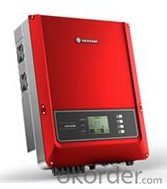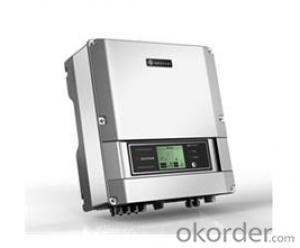Solar Inverter On-Grid Type Solartec Central 500
- Loading Port:
- Shanghai
- Payment Terms:
- TT OR LC
- Min Order Qty:
- 10 unit
- Supply Capability:
- 1000 unit/month
OKorder Service Pledge
OKorder Financial Service
You Might Also Like
3. High effiency and low noise
.2. Can used out of doors
The photovoltaic grid-connected inverters in the Solartec Central 250/500 series are applicable to rooftop projects and power plant projects. The nominal output powers of Solartec Central 250 and Solartec Central 500 are 250 kW and 500 kW respectively.
1. Powered by DC current
This series has the Siemens core inverter module, an advanced MPPT algorithm and advanced circuit topology. They have a high conversion efficiency. They have a fast and highly accurate control chip, and have the functions of reactive power compensation, harmonic controlling, overcurrent protection, overvoltage protection, temperature protection, active and passive islanding detection and low-voltage ride through. Additionally, they support optical fiber remote monitoring and have reached European certification standards, including Germany’s.

Product Advantages:
1. Powered by DC current
2. Can used out of doors
3. High effiency and low noise
FAQ:
What is your payment terms?
We accept T/T payment, normally we need 20% T/T in advance, 80% payed before shipment.
What is your packing system?
We put the sistem in the wooden box.
Can you do OEM service?
Yes we can, but we need to do it with a certain order quantity.
- Q:What are the key safety features to look for in a solar inverter?
- The key safety features to look for in a solar inverter include: 1. Overvoltage and undervoltage protection: This feature ensures that the inverter can handle voltage fluctuations and prevents damage to the electrical system. 2. Ground fault protection: It is essential for the inverter to have ground fault protection to prevent electric shocks and ensure the safety of the system. 3. Anti-islanding protection: This feature ensures that the solar inverter shuts down in the event of a power outage, preventing it from sending power back to the grid and endangering utility workers. 4. Overtemperature protection: A reliable solar inverter should have overtemperature protection to prevent overheating and potential fire hazards. 5. Surge protection: The inverter should have built-in surge protection to safeguard against power surges caused by lightning strikes or grid fluctuations. 6. Arc fault protection: This safety feature detects and mitigates the risk of arc faults, which can result in electrical fires, by rapidly shutting down the inverter. 7. Monitoring and fault detection: A good solar inverter should have a monitoring system that detects faults or abnormalities in real-time, allowing for prompt maintenance and troubleshooting. 8. Compliance with safety standards: Ensure that the solar inverter complies with relevant safety standards, such as UL (Underwriters Laboratories) or IEC (International Electrotechnical Commission), to guarantee its safety and reliability. By considering these key safety features, you can ensure the overall safety and performance of your solar inverter system.
- Q:How does a solar inverter handle partial shading on solar panels?
- A solar inverter handles partial shading on solar panels by utilizing a technique called Maximum Power Point Tracking (MPPT). MPPT allows the inverter to constantly monitor and adjust the voltage and current levels of each solar panel to ensure that it operates at its maximum power output despite shading. This is achieved by dynamically redistributing power between the shaded and unshaded panels, optimizing the overall energy generation of the entire solar array.
- Q:What is the role of a solar inverter in preventing electrical hazards?
- The role of a solar inverter in preventing electrical hazards is to convert the direct current (DC) generated by solar panels into alternating current (AC) that is suitable for use in homes and businesses. By ensuring the safe and efficient conversion of power, solar inverters help to minimize the risk of electrical hazards such as electrical shock, fire, or damage to electrical appliances and equipment. They also incorporate safety features like ground-fault protection and overvoltage protection, further enhancing their role in preventing electrical hazards.
- Q:Can a solar inverter be connected to a smart home or monitoring system?
- Yes, a solar inverter can be connected to a smart home or monitoring system. This allows for seamless integration and monitoring of the solar system's performance and energy production. This connection enables homeowners to track their energy usage, receive real-time updates on energy generation, and even remotely control and optimize the solar system's settings.
- Q:How does a solar inverter handle shade on solar panels?
- A solar inverter handles shade on solar panels by utilizing Maximum Power Point Tracking (MPPT) technology. This technology continuously monitors the solar panels' output and adjusts the voltage and current to maximize energy production. When shade falls on a panel, the MPPT algorithm identifies the affected panel and dynamically adjusts its output to minimize the impact of shade on the overall system performance. This ensures that even partially shaded panels can still contribute to the overall energy generation of the solar installation.
- Q:How do you monitor the performance of a solar inverter?
- One way to monitor the performance of a solar inverter is by using a monitoring system or software specifically designed for this purpose. These systems typically collect data from the inverter, such as energy production, voltage levels, and operating parameters, and provide real-time analytics and reports. By regularly reviewing this information, any anomalies or issues can be quickly identified and addressed, ensuring the optimal performance of the solar inverter.
- Q:How does the quality of the AC waveform affect the performance of a solar inverter?
- The quality of the AC waveform directly affects the performance of a solar inverter. A clean and stable waveform is essential for efficient and reliable operation of the inverter. Any deviations, distortions, or harmonics in the waveform can lead to increased power losses, reduced conversion efficiency, and potential damage to the inverter. Therefore, a high-quality AC waveform is crucial for optimal performance and maximum power output from a solar inverter.
- Q:Can a solar inverter be used in remote areas without access to the grid?
- Yes, a solar inverter can be used in remote areas without access to the grid. Solar inverters are designed to convert the direct current (DC) electricity generated by solar panels into alternating current (AC) electricity that can be used to power electrical appliances. In remote areas, solar panels can be installed to harness sunlight and convert it into electricity, which can then be used through the solar inverter to provide power to homes, businesses, or any other electrical devices without the need for a grid connection.
- Q:What is the role of a solar inverter in preventing electrical faults?
- The role of a solar inverter in preventing electrical faults is to convert the direct current (DC) electricity generated by solar panels into alternating current (AC) electricity that can be used in homes and businesses. In doing so, the inverter helps maintain a stable and consistent flow of electricity, which reduces the risk of electrical faults such as short circuits, overloads, or voltage fluctuations. It also includes various protection mechanisms, such as ground fault detection and interruption, to ensure the safety and reliability of the solar power system.
- Q:What is the role of a transformer in a solar inverter?
- The role of a transformer in a solar inverter is to convert the direct current (DC) electricity generated by the solar panels into alternating current (AC) electricity suitable for use in homes and businesses. The transformer helps to step up or step down the voltage levels, ensuring efficient and safe transmission of electricity from the solar panels to the electrical grid or connected loads.
1. Manufacturer Overview |
|
|---|---|
| Location | |
| Year Established | |
| Annual Output Value | |
| Main Markets | |
| Company Certifications | |
2. Manufacturer Certificates |
|
|---|---|
| a) Certification Name | |
| Range | |
| Reference | |
| Validity Period | |
3. Manufacturer Capability |
|
|---|---|
| a)Trade Capacity | |
| Nearest Port | |
| Export Percentage | |
| No.of Employees in Trade Department | |
| Language Spoken: | |
| b)Factory Information | |
| Factory Size: | |
| No. of Production Lines | |
| Contract Manufacturing | |
| Product Price Range | |
Send your message to us
Solar Inverter On-Grid Type Solartec Central 500
- Loading Port:
- Shanghai
- Payment Terms:
- TT OR LC
- Min Order Qty:
- 10 unit
- Supply Capability:
- 1000 unit/month
OKorder Service Pledge
OKorder Financial Service
Similar products
New products
Hot products
Hot Searches
Related keywords






























